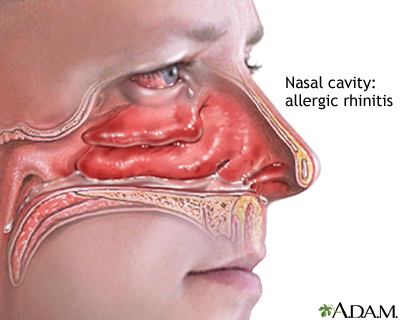Allergic rhinitis is a diagnosis associated with a group of symptoms affecting the nose. These symptoms occur when you breathe in something you are allergic to, such as dust, animal dander, or pollen. Symptoms can also occur when you eat a food that you are allergic to.
This article focuses on allergic rhinitis due to plant pollens. This type of allergic rhinitis is commonly called hay fever or seasonal allergy.
An allergen is something that triggers an allergy. When a person with allergic rhinitis breathes in an allergen such as pollen, mold, animal dander, or dust, the body releases chemicals that cause allergy symptoms.

Hay fever involves an allergic reaction to pollen.
Plants that cause hay fever are trees, grasses, and weeds. Their pollen is carried by the wind. (Flower pollen is carried by insects and does not cause hay fever.) Types of plants that cause hay fever vary from person to person and from area to area.
The amount of pollen in the air can affect whether hay fever symptoms develop or not.
- Hot, dry, windy days are more likely to have a lot of pollen in the air.
- On cool, damp, rainy days, most pollen is washed to the ground.
Hay fever and allergies often run in families. If both of your parents have hay fever or other allergies, you are likely to have hay fever and allergies, too. The chance is higher if your mother has allergies.
Symptoms that occur shortly after you come into contact with the substance you are allergic to may include:
- Itchy nose, mouth, eyes, throat, skin, or any area
- Problems with smell
- Runny nose
- Sneezing
- Watery eyes
Symptoms that may develop later include:
- Stuffy nose (nasal congestion)
- Coughing
- Clogged ears and decreased sense of smell
- Sore throat
- Dark circles under the eyes
- Puffiness under the eyes
- Fatigue and irritability
- Headache
https://medlineplus.gov/ency/article/000813.htm